
My goal while making Moonshot was to evoke Apollo 11, not to overwhelm readers with its details.
But maybe you like details. Maybe you've asked, what’s with those yellow shoes? What are those things sticking off the legs of the Lunar Module? And who’s MOM?
If yes, open a copy of Moonshot and read on. The following are intended as annotations, a director’s commentary track, and footnotes. I hope they provide an interesting addition to the book.
Brian Floca
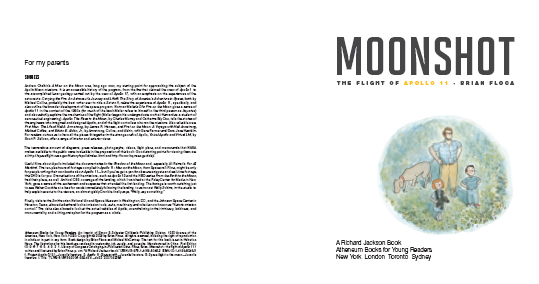

It’s July, the fireflies are out, and a new crescent Moon, barely there, is overhead. Our family is outside with a pair of binoculars. Even a pretty mundane pair of binoculars will bring to life the texture of the Moon's surface, the shadows dipping into craters. It’s a real place!
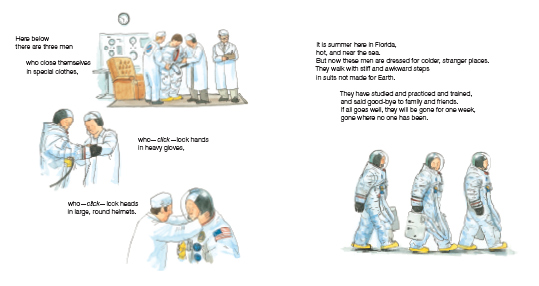
SUITING UP
In Liftoff: The Story of America’s Adventure in Space, Michael Collins writes, “A space flight begins when the technician snaps your helmet down into your neck ring and locks it in place. From that moment on, no outside air will be breathed, only bottled oxygen; no human voice heard, unless electronically piped in through the barrier of the pressure suit. The world can still be seen, but that is all — not smelled, or heard, or felt, or tasted.”
Here is that moment for the crew of Apollo 11. It is a moment that came early on the morning of the flight. Note the clock on the wall: That’s A.M.
The silver cases the astronauts carried are portable oxygen systems; they supplied the astronauts with air to breathe until the astronauts boarded their spaceship and were connected to the onboard oxygen.
And the yellow shoes? Slippers that the astronauts wore over their suits until just before they climbed into Columbia. That helped keep the spacesuits clean, and the inside of the spaceships, too.
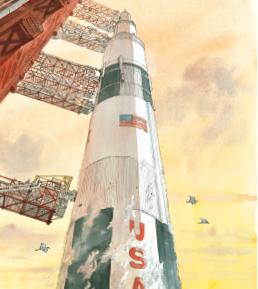
THE SATURN V
In his book A Man on the Moon, Andrew Chaikin writes, “Everything about the Saturn V was grossly out of scale with the rest of the world.” Fully fueled, he writes, the Saturn V “would contain the explosive energy of an atomic bomb. This engineering masterpiece was designed to tame that energy and liberate it in a sustained, fiery release of power.”
Steam swirled at the base of the rocket because the rocket was filled with supercooled fuels, kerosene, liquid oxygen, and liquid hydrogen — fuels so cold that by launch time moisture from the Florida air formed a thin skin of ice on the rocket. (More about that ice when the rocket launches.)
At the highest of the swing arms that reach out to the Saturn V from the launch tower, look for the astronauts (you can spot their yellow feet) making their way toward the White Room at the swing arm’s end (not visible here). The White Room opened onto the hatch of the Command Module, and it's from inside the White Room, a glimpse of which you get on the right-hand page, that the astronauts board Apollo 11. The fellow in the bow tie closing the hatch is a nod to Guenter Wendt, Pad Leader through the Apollo missions.
The herons here are a small reference to Anne Morrow Lindbergh’s essay “The Heron and the Astronaut,” a meditation on her and husband Charles Lindbergh’s visit to Cape Canaveral (then Cape Kennedy) to watch the launch of Apollo 8, the first flight to leave Earth orbit and to orbit the Moon. Lindbergh wrote about how Apollo’s flights to the Moon might affect our view of life on the Earth — thoughts encouraged by the meeting of nature and technology at the Cape, home not only to NASA, but also the Merritt Island National Wildlife Refuge. The refuge is currently home to a dozen bald eagle nests and, says NASA, “also includes several wading bird rookeries, many osprey nests, up to 400 manatees during the spring, and approximately 2,500 Florida scrub jays. It also is a major wintering area for migratory birds. More than 500 species of wildlife inhabit the refuge, with 15 considered federally threatened or endangered."

MISSION CONTROL
The Mission Control from which the Apollo missions were run is now known as “historic Mission Control.” You can see it today if you visit the Johnson Space Center in Houston, Texas. It’s no longer used and has been restored to an Apollo-era appearance. Notice the 1960s-era technology: pneumatic tubes, a manual pencil sharpener, a slide ruler, and rotary dials.
Mission Control took over responsibility for the flight as soon as Launch Control at the Cape saw the rocket clear of the launch tower. In Apollo: The Race to the Moon, Charles Murray and Catherine Bly Cox describe the tight-knit, dedicated culture that formed in the crucible of Flight Operations. Flight Operations “tended to hire predominantly new college graduates. Furthermore, [director of Flight Operations Chris] Kraft looked for a particular kind of person…. Most of all, he looked for applicants who were fascinated by space flight and who couldn’t believe their good fortune when they were given the opportunity to work sixty-hour weeks at a Civil Service salary — as long as they were going to be working for the space program.”
Murray and Cox continue: “So there they were — young, male, in a high-pressure job, often the only one they’d ever known, many of them single, spending most of their working hours together, often in remote overseas outposts, led by men they idolized…. Sometimes it seemed that the controllers lacked only decoder rings and a treehouse.”
Projected onto the screen on the right is a page from the Apollo 11 flight plan, detailing the timing of the ignition and launch sequence and related events. For instance, you can see that “Max Q” occurs at the 1:21 mark; Max Q represents the moment of maximum dynamic pressure on the rocket. You can also see that this is for a “G” mission. A, B, C, D, E, and F type missions tested various elements of Apollo machinery and procedures. G designated a manned lunar landing.
And in the middle of the page, just left of center, wearing one of his signature vests, there’s Gene Kranz, the flight director made famous (more famous?) by Ed Harris’s portrayal in Ron Howard’s "Apollo 13."
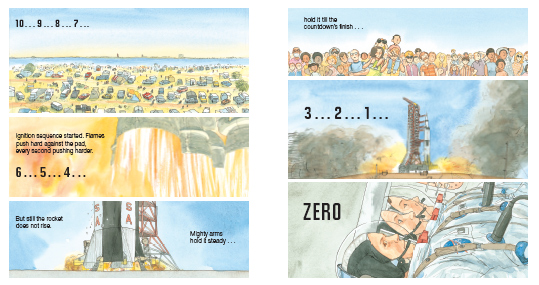
COUNTDOWN
Ignition occurred just past the nine second mark. Powerful hold-down arms kept the rocket steady and in place as the engines built the thrust necessary to lift the six and one half million pound rocket.
Norman Mailer described the process in his book Of a Fire on the Moon: “Does the rocket weigh six million, four hundred and eighty-four thousand, two hundred and eighty pounds? Now the thrust goes up, the flames pour out, now the thrust is four million, five million, six million pounds, an extra million pounds of thrust each instant as those thousands of gallons of fuel rush every second to the motors, now it balances at six million, four hundred and eighty-four thousand, to hundred and eighty pounds. The bulk of Apollo-Saturn is in balance on the pad. Come, you could now levitate it with a finger, but for the hold-down arms.”
By zero the engine thrust had well surpassed the weight of Apollo 11; at that mark the hold-down arms released their grip and the rocket took flight.
In many movies about Apollo, and even in some documentaries, the liftoff scenes are edited so that the engines ignite at the end of the countdown: three, two, one, zero, ignition! I imagine filmmakers alter the sequence so they can spend more time with those vivid images of the engines coming to life; those few seconds pass very quickly in the unedited actual footage. Time moves differently on the page, though, and I was glad to be able to stay true to how the launch actually occurred: three, two, one, zero, liftoff!

LIFTOFF!
Remember the skin of ice that formed around the rocket? That’s what creates those shards and flakes that come snapping and floating off the rocket at liftoff.
The two stubby structures beneath the rocket are the hold-down arms. (Two more, not visible here, are on the other side of the column of fire lifting the rocket.)
The platform is wet here because it was flooded with water as the rocket lifted off — an effort to mitigate the heat damage to the platform.
Finally, probably the most obscure thing I researched while making the book concerned the engines. Most pictures of the Saturn V’s F-1 engines and most museum displays show a wonderfully complicated thing loaded with pipes and patterns and detail, and that’s how I began this drawing:
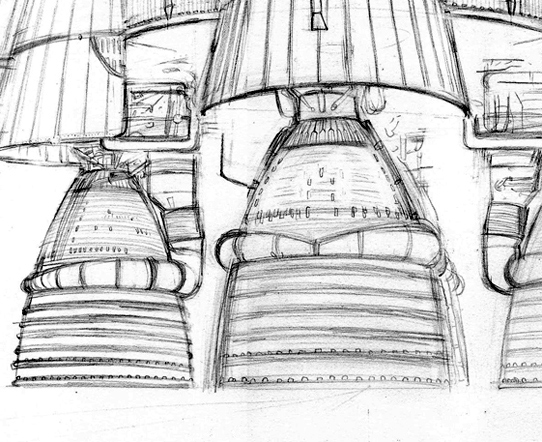
But reviewing launch footage, I kept noticing how much smoother the engine bells looked. I finally learned that there was a batting of insulation around the engines at liftoff, to protect them from the very heat they were generating. For some reason this insulation barely ever makes it into a depiction of a launch. Maybe because the insulation is less interesting to look at than an unshielded engine, at least it is if you like gadgetry, and I do. Regardless, it was back to the drawing board for this page.
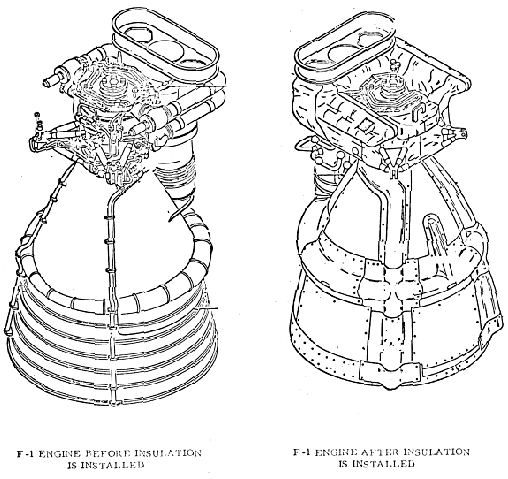
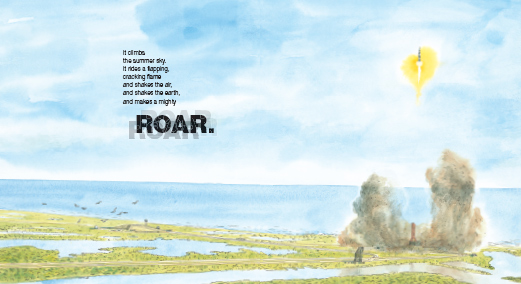
In this long view of the launch, the crawl way leading to the launch pads (39-B on the left, and 39-A on the right) may give a false sense of scale. Each “lane” here is itself the size of a good road. (You can see these lanes from a different perspective, with a better sense of scale, in the first panel on the front endpapers.)
The gantry in the foreground is the Mobile Service Structure. Apollo 11 was moved from the Vehicle Assembly Building onto the launch pad almost two months before its flight, and for much of that time the Mobile Service Structure was parked up against it to provide support for final launch preparations. Then the structure was moved to where you see it on this page. (I finally learned where it was parked during the launch itself by skimming a Douglas Aircraft Saturn V Payload Planners Guide.)
The closest observers were three miles from the pad — a distance determined to be safe for the observers if the rocket exploded. Even at that distance, the liftoff of a Saturn V made a terrific impression.
Here’s Anne Morrow Lindbergh on the launch of Apollo 8:
“Slowly it rises and — because of our distance — silently, as in a dream. Suddenly the noise breaks, jumps across our three separating miles — a shattering roar of explosions, a trip hammer over one’s head, under one’s feet, through one’s body. The earth shakes; cars rattle; vibrations beat in the chest. A roll of thunder, prolonged, prolonged, prolonged.”
And here’s a passage by Norman Mailer (writing in the third person as Aquarius), again from Of a Fire on the Moon, on the launch of Apollo 11. He, too, watched from a distance and was struck first by the silence:
“[T]his slim angelic mysterious ship of stages began to ascend slowly into the sky, slow as Melville’s Leviathan might swim, slowly as we might swim upward in a dream looking for the air. And still no sound.
Then it came, like a crackling of wood twigs over the ridge, came with the sharp and furious bark of a million drops of oil crackling suddenly into combustion, a cacophony of barks louder and louder as Apollo-Saturn fifteen seconds ahead of its own sound cleared the lift tower to a cheer which could have been the cry of anguish from that near-audience watching; then came the ear-splitting bark of a thousand machine guns firing at once, and Aquarius shook through his feet at the fury of this combat assault, and heard the thunderous murmur of Niagaras of flame roaring conceivably louder than the loudest thunders he had ever heard and the earth began to shake and would not stop, it quivered through his feet standing on the wood of the bleachers, an apocalyptic fury of sound equal to some conception of the sound of your death in the roar of a drowning hour, a nightmare of sound, and he heard himself saying, “Oh, my God! oh, my God! oh, my God! oh, my God! oh, my God! oh, my God!”...and the sound of the rocket beat with the true blood of fear in his ears...and a poor moment of vertigo at the thought that man now had something with which to speak with God....”
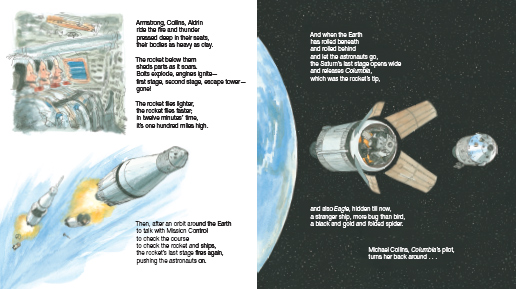
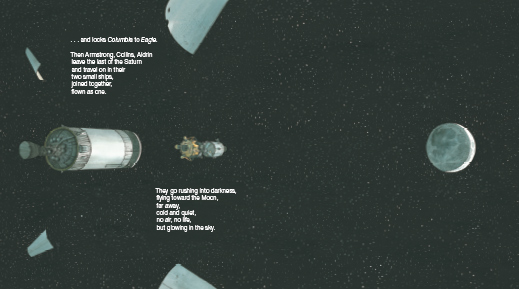
The way an Apollo mission took itself apart and put itself back together was hard to explain in the simple language I wanted for Moonshot, especially the maneuver known as Transposition and Docking, in which the Command and Service Module (CSM) separated from the final section of the Saturn V rocket, turned around, docked with the Lunar Module (LM), and pulled the LM free of the Saturn. (See what I mean?) Hopefully between the explanation here and on the endpapers, the procedure is clear. Once the two ships were docked, hatches were opened that allowed the astronauts to move from the CSM to the LM through a small tunnel.
One of the interesting things in reading about the Apollo missions, by the way, was learning how much each mission learned from previous missions. For instance, the four large panels that enclosed the LM were originally designed not to detach from the Saturn; they were simply to open on hinges. On Apollo 7, the astronauts who flew the Saturn in space for the first time suggested that those panels could get in the way when the CSM turned around to dock with the LM. (You can see why they might think so by looking at this photo from Apollo 7.) Better, they said, to have the panels detach and float away, and on future missions they did.
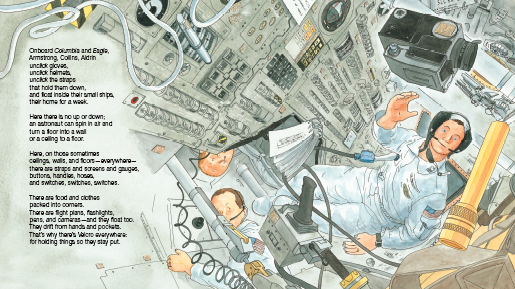
Many of the objects floating in this scene are on display at the Smithsonian Air and Space Museum in Washington, D.C. While I drew Armstrong floating in pursuit of a Hasselblad camera, I put astronauts Collins and Aldrin in positions related to their roles on the mission. As Lunar Module Pilot, Aldrin was responsible for checking Eagle’s systems and making sure everything was functioning properly after the launch, so here his head is poking into the CM from the tunnel that leads to the LM. (Because of how the ships docked together, astronauts made upside-down entrances when they went from one craft to the other.) As Command Module Pilot, Michael Collins was responsible for navigation, so here he is looking up (down? over?) from the guidance and navigational instruments in the lower equipment bay.
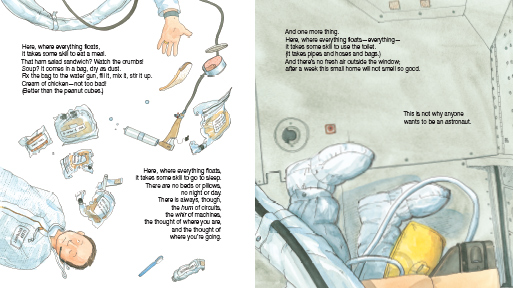
You can find footage of Buzz Aldrin making one of those ham salad sandwiches here (part 1) and here (part 2). Footage of Collins slipping comfortably into a sleep restraint is here. I know of no footage that involves the urine collection device. What Moonshot says about fresh air is inferred from what Andrew Chaikin, in A Man on the Moon, writes about when the hatch was opened after the splashdown of Apollo 8: “After six days of living in a flying toilet they didn’t even notice how bad it smelled inside Apollo 8. But when that first swimmer opened the hatch, he reeled backwards as if he’d been kicked in the head.” Then again, Frank Borman also threw up on Apollo 8, so maybe 11 had it a little better. It couldn't have smelled great in there, though.

The line “it pulls them in” is not a figure of speech; once Apollo 11 entered the Moon’s gravitational influence, the Moon was literally drawing the ships toward it.
The Moon, by the way, has been moving through its phases as the book has progressed. How the sun was hitting the Moon was a consideration for mission planners, who wanted best possible lighting conditions for the landing attempt. They wanted the light to be coming from behind the astronauts as Eagle descended to the lunar surface. (It is easier to drive with the sun at your back, instead of in your face.) Planners also wanted light to be hitting the site at a relatively low angle, about ten degrees, to put surface features into helpful relief. Therefore Apollo 11 was timed to arrive at the Moon when those conditions would appear at the chosen landing site on the Sea of Tranquility. This also explains why in all the photos of LMs on the Moon the front of the lander is always in complete shadow, for all the LMs landed facing away from the sun.
And speaking of Moon phases, if you want to know the phase of the Moon on any given day in history (as I did while making this book), you can find it here.

At the Moon, Columbia and Eagle separated and the legs on Eagle, folded till now, opened to their landing position. Here's Collins describing the process. His account begins with him in Columbia and Armstrong and Aldrin in Eagle; the craft are about to separate:
"You cats take it easy on the lunar surface...." "O.K., Mike," Buzz answers cheerily, and I throw the switch which releases them. With my nose against the window and the movie camera churning away, I watch them go. When they are safely clear of me, I inform Neil, and he begins a slow pirouette in place, allowing me a look at his outlandish machine and its four extended legs. "The Eagle has wings'" Neil exults.
It doesn't look like any eagle I have ever seen. It is the weirdest-looking contraption ever to invade the sky, floating there with its legs awkwardly jutting out above a body which has neither symmetry nor grace. I make sure all four landing gears are down and locked, report that fact, and then lie a little, "I think you've got a fine-looking flying machine there, Eagle, despite the fact you're upside down."
(Quote is from here.)
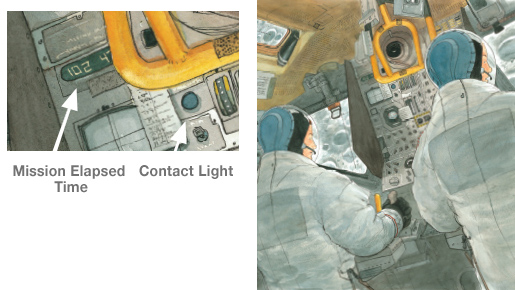
LANDING
Inside Eagle, that's Armstrong is on the left and Aldrin the right. Aldrin's title, Lunar Module Pilot, is a misnomer; Armstrong is flying the ship. Both are standing; to reduce the weight of the LM and make it easier to launch into space, the designers of the LM stripped away every possibly unnecessary element — including seats. Restraining cords that attach to clips at the astronauts’ hips help hold them in place.
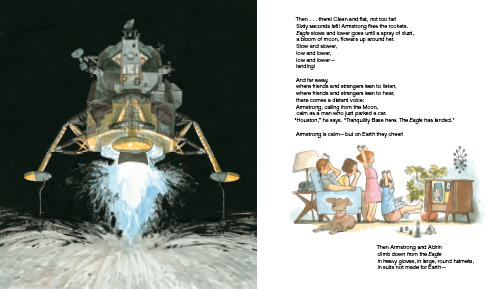
Thin probes extend below three of the four landing pads on the Eagle. Once those touch the lunar surface, a Contact Light inside the LM illuminates. (Look for the small blue circle on the panel in the interior scene — that’s the light.) That lets the astronauts know to cut the engine. A probe was originally planned for the front footpad, too, but astronauts saw the possibility of the probes bending up in unexpected ways on landing and getting in the way of the crew, so that prong was omitted.
Because there is no air and thus no air resistance on the Moon, the dust kicked up by Eagle’s descent engine does not billow or churn; it flies out from beneath the LM in perfect arcs.
The clock on the wall puts our family in Eastern time, but the landing was watched all over the world. And while he’s just a sketch here, when I drew this anchorman I was looking at and thinking of Walter Cronkite, who was, in an era when newscasters kept more of a straight face than they do now, visibly relieved and excited at the landing. The CBS/Cronkite coverage of the landing occasionally appears on YouTube.
All of the exterior views of the LM in the CBS footage were of course models, some of which look better than others. After the landing, the plan at CBS was for the camera to cut to a view of another LM at Grumman on Long Island, New York, where the LMs were built, to give viewers an idea of what Eagle looked like resting on the Moon. If you can find the footage, notice that the camera cuts to the Grumman LM early, before the landing has actually occurred; CBS followed the flight plan to the second, but Armstrong and Aldrin took extra time to find a landing site. You can hear program alarms and warnings about fuel (“Thirty seconds.”) in the background as they do.
Six hours then passed before Armstrong and Aldrin were ready to descend from Eagle and walk the Moon.
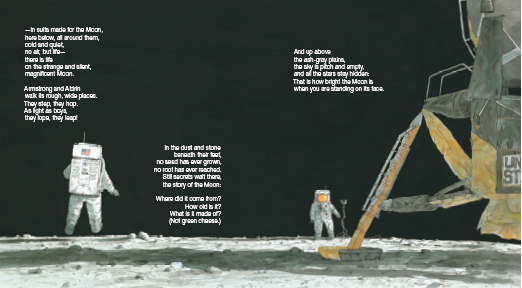
On the far side of Eagle is the bottom of an open hatch cover. That’s the MESA — the Modularized Equipment Stowage Assembly. Before Armstrong climbed down Eagle’s ladder to the Moon, he pulled a cord that opened the MESA which contained, among other things, the camera that sent the footage of Armstrong’s descent down the ladder back to Earth. If you look back a page to the drawing of the Eagle landing, you can see the outline of the MESA hatch (still closed) in the bottom stage of the LM, just to the right of the American flag.
A map of the area that Armstrong and Aldrin covered while on the Moon, laid over a soccer field for scale, is here. You'll see that they didn't get far. Later landings stayed on the surface longer and covered more terrain.
The line "As light as boys" refers to gravity on the Moon, one-sixth as strong as on Earth. Here Aldrin describes the Moon walk:
"I took off jogging to test my maneuverability. The exercise gave me an odd sensation and looked even more odd when I later saw the films of it. With bulky suits on, we seemed to be moving in slow motion. I noticed immediately that my inertia seemed much greater. Earth-bound, I would have stopped my run in just one step, but I had to use three of four steps to sort of wind down. My Earth weight, with the big backpack and heavy suit, was 360 pounds. On the Moon I weighed only 60 pounds."
(Source for above quotes is here.)
And where are the stars? One of the great recurring questions about photos of the Moon landing! The answer: Though the black sky of the Moon reminds one of night, remember that the astronauts were standing in full sunlight, sunlight brighter than here on Earth, where there is an atmosphere to soften the sun's rays. And just as on Earth, when the eye (or camera) has adjusted to the full glare of the sun, the small and dim light of stars can’t be seen.

Here’s Armstrong on the Moon. So that he can get a clear view of Earth (actually, so that we can get a clear view of him), he’s lifted the top visor of this helmet. That visor, covered with a gold optical coating, helped mitigate the glare of the sun. More about the Apollo helmets is at the Smithsonian web site, here. A video of Buzz Aldrin handling a helmet in the LM is here.
The Hasselblad camera that the astronauts used is attached to a bracket on his chest. (Specifically, attached to the front of the Remote Control Unit (RCU), which was used to control the Portable Life Support System (PLSS) that the astronauts carried on their backs.) Armstrong and Aldrin shared the camera. As it happened, very nearly all of the pictures from the mission that show an astronaut show Aldrin. The men were wearing identical suits, so it might be hard to tell them apart even if we had good photos of both. That issue was addressed on later missions by giving mission commanders red stripes on their suits and helmets.
People sometimes ask about the word “MOM” when they see it on the RCU. The switch on the bottom of the RCU is the push-to-talk switch used to control radio communications. MAIN set the transmitter to voice activated mode, in which the system began transmitting automatically when the astronaut spoke. OFF meant off, and MOM stood for momentary voice communication: as long as the switch was held in the MOM position, transmission and reception were activated. When the switch was released from MOM, it automatically went back to OFF.
Also note the mission checklist on the sleeve of Armstrong’s glove. See the glove and read the checklist for yourself here. (More details of the suit here.) Astronauts on later missions — with more time on the Moon and with longer checklists — wore small spiral-bound notepads attached to their gloves. Finally note Armstrong’s watch; the astronauts operated on Central Time, coordinated with Mission Control.

It was night in the Western Hemisphere when the astronauts made their spacewalk, and the Pacific side of Earth that faced the Moon (with the South Pole on the left side of the Earth, and the North Pole on the right). The astronauts’ transmissions were sent to a receiving station in Australia (a continent only suggested here; astronauts reported that continents were seldom clear through the clouds and atmosphere) and from Australia to the world.
I tried to add a slight curve to the Moon's horizon line on this page. In A Man on the Moon, Chaikin describes Aldrin’s impressions of being on the Moon: “The land curved gently but noticeably away from him, all the way out to the horizon, which was only a mile and a half away. He could actually see that he and Armstrong were standing on a sphere.”
You can also look on this page for the various experiments deployed by Armstrong and Aldrin during their walk on the Moon.
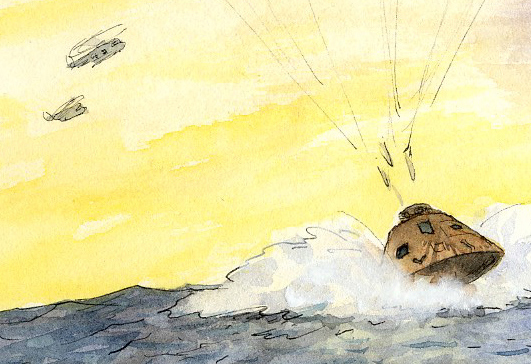
HOME
From there it was a smooth flight for Armstrong and Aldrin back to lunar orbit, and then for Armstrong, Collins, and Aldrin back to Earth. It was noon in Houston but dawn in the Pacific when Columbia splashed down, scarred and browned by the intense fires of reentry. That was only on the outside, though. Inside, Armstrong, Collins, and Aldrin were safely home. You can see Columbia today — the only component of Apollo 11 to make it back to Earth intact — at the Smithsonian Air and Space Museum in Washington, D.C. More about Columbia at the Smithsonian is here.
In the background, a Sikorsky Sea King Helicopter is on its way to pick up the crew. The number 66 is virtually impossible to see in the book, but it's there; “Helo 66” was the recovery helicopter for five of the Apollo missions.
The only other thing to add is that the drama of return and reentry easily merited longer treatment — but there are limits to how many pages you get to put in one of these books!

THE END
And that's it. July is drawing to its close, the Moon is full in the sky, the astronauts are back to Earth, and we’ve reached the end of what President Richard Nixon called “the greatest week in the history of the world since Creation.”
If Nixon got a little carried away, let’s not blame him. It was a remarkable trip!